![]()
![]()
![]()
Use LEFT and RIGHT arrow keys to navigate between flashcards;
Use UP and DOWN arrow keys to flip the card;
H to show hint;
A reads text to speech;
14 Cards in this Set
- Front
- Back

|
-archaic roundhead style -ancient rock art from the central sahara -shows a spiritual being, a horned figure - people that made this come from a society that depend on cattle/livestock -things emanating from arms/hips represent palm fibers that were used during religious dances, could represent rainfall -hierarchy of scale (small, darker figures next to her) -legs terminate in knobs - depicting cloth that would cover hands/feet during mask dancing ceremonies |
|
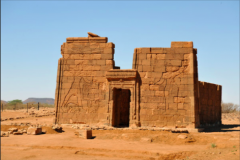
|
-carvings on the outside are relief style -sudanese king and queen on the front -lack of hierarchy of scale suggests that sudanese queens had more political power than those in egypt -stepping forward to strike, but wearing common dress -one room temple -used to keep lions there to enhance power of temple |
|
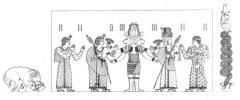
|
-relief style -apedemak = local diety specific to nubian people -lion head with human body shows local forms of religion, is wearing a regional dress -winding snake = reference to local practice of nubian burial rituals of kings -no hierarchy of scale |
|
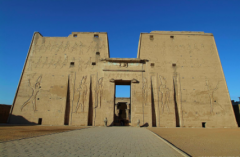
|
-classic use of hierarchy of scale -dedicated to horus |
|
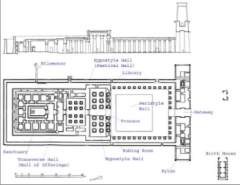
|
-follows egyptian style where the temple gets smaller, more cramped, darker the farther you go in - transition from light to dark until you get to a statue of the deity at the of the temple (deities thought to have been "born" from the dark) |
|
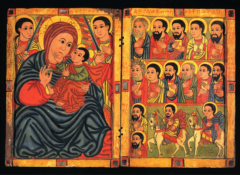
|
-siyon ( a monk) worked under the kings of the solomonic period in ethiopia -ethiopian king at the time commissioned siyon to make this to reach out to the illiterate people of ethiopia in order to spread christianity all around -portable - folded like a book -bold, flat colors (distinct mark of artist) -flat sense of space |
|
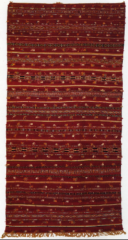
|
-berber women's art -key to berber women's art: ambiguity or multiplicity of meaning, change over time, religious adaption/syncretism (bringing together of diff religions/cultures) -small geometric symbols -lots of negative space -intentional asymmetry -lots of the same symbols/patterns also used in ceramics/pottery -wool has "baraka" (blessing) -woman weaving textile is creating life/birthing the textile.. when the piece is cut from the loom it "dies" |
|
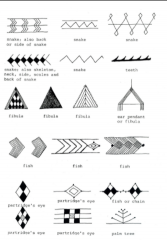
|
-berber women's art, symbols -women give textile life, related to a woman's fertility, cut from the loom means the textile dies -triangle = basic building block, abstract, protection against the evil eye -spider (baraka) -bird (messenger between heaven and earth) -lizards, snakes, turtles protect against the evil eye -evil eye - greed/jealousy is dangerous and if you have success you need to wear things to ward off the evil eye or else you -patterns used on textiles, ceramics, henna, tattoos, clothing |
|
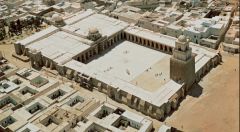
|
-one of the earliest mosques in n. africa -served as a prototype for other mosques- others copied its courtyard, prayer hall, colonnade, hypostyle hall -notes |
|
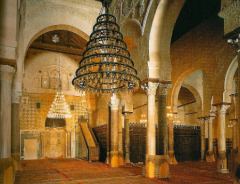
|
-mosque terminology in notes -columns taken from other buildings and used in the mosque - |
|
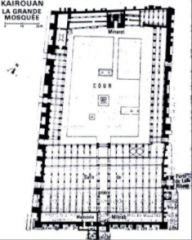
|
-great mosque a prototype for mosques built after it -notes |
|
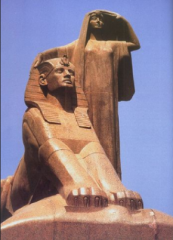
|
-first egyptian modern artist -sphynx a reference to ancient egyptian art -peasant woman protecting sphynx -shows tie between contemporary peasants and ancient egyptians - "we are all descendants of the pharaohs" -created during the 1919 uprisings (in response to british colonization - british would take crops, dehumanize egypitans) -calling for egyptians to revive the glory of ancient egypt (to once again become a free and sovereign nation) -funded by nationalist parties -peasant woman depicts no one in particular - supposed to be just a common woman (probably a farmer - a big goal of the wafd party was to tell people that if they could harness egypt's great agriculture/farming powerhouse, they could build up wealth and free themselves from british occupation) -sexist in that woman is a symbol for the nation of egypt, depicted in this glorious way on the statue.. but huge lack of women's rights during the time (Huda Shaarawi), women were not allowed at the unveiling ceremony |
|
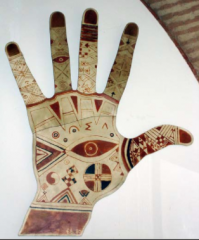
|
-large scale -artist part of the casablanca group -artist not berber -wanted to form a moroccan national art -took motifs from berber women's art (like textiles) -liked to combine different art forms -arab islamic nationalism wanted to suppress berber's language - artist depoliticizes tifinagh script, uses the symbols "as decoration" -supports the berber myth by making the art look super old - makes it look like the berbers are ancient, don't change -appropriation of the berber people? not including any of the symbolism/culture of the tifinagh script, of the berber style |
|
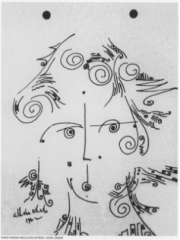
|
-okeke of igbo descent (from nigeria) -draws on designs of idgo women's uli designs -western medium (pen on paper) -techniques pull from Igbo heritage -natural synthesis - compels the artist to study an art form indigenous to his/her ethnicity and form a style on the basis of that art -zaria arts society formed right around when nigeria was breaking free from british colonization - trying to form a modern nigerian art in this context -line as an index of the artist's activity |

